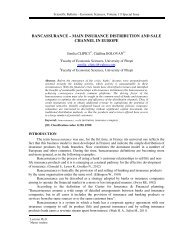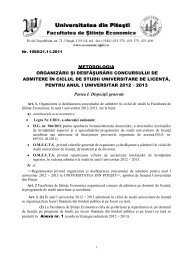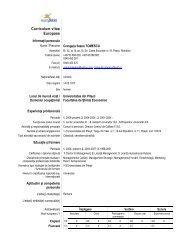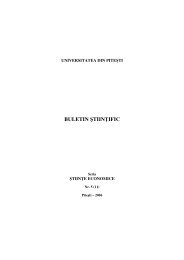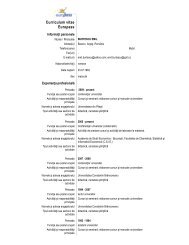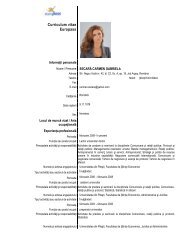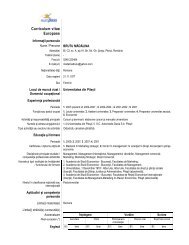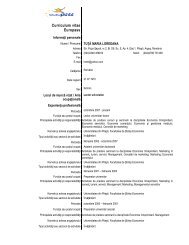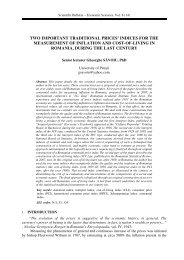buletin Åtiin ific - Facultatea de Stiinte Economice - Universitatea din ...
buletin Åtiin ific - Facultatea de Stiinte Economice - Universitatea din ...
buletin Åtiin ific - Facultatea de Stiinte Economice - Universitatea din ...
- No tags were found...
You also want an ePaper? Increase the reach of your titles
YUMPU automatically turns print PDFs into web optimized ePapers that Google loves.
Some Potential Econophysics’ Mo<strong>de</strong>ls for Real Economic Convergenceexclusively through market forces, since they rather tend to cause divergence andpolarization. For this purpose, special tools and mechanisms are required (e.g.: cohesion). Manystudies <strong>de</strong>al with the economic convergence of the European countries and especially theconvergence of the UE27 countries, inclu<strong>din</strong>g Romania. Mo<strong>de</strong>ls are used to assess the economicgrowth, approximate the period of real convergence of Romania to the EU, as well as to estimatethe σ- and ß-convergence, and the main shortcomings of the last indicator. Within the currentcomplex economic and dynamic environment, integrationist processes are particularly takingplace in various geographic areas in different forms and at variable intensity. This integrationistphenomenon of economic convergence occurs continuously or intermittently or this phenomenonmay be related to the emergence of cooperation in social/ecological systems.What economic integration really means? Economic integration means reaching the aimsof social and economic convergence, aims which are periodically <strong>de</strong>fined and updated accor<strong>din</strong>gto historic requirements. The convergence issue holds a major role in the theory of economicgrowth. The hypotheses of catching up with rich countries by the poor ones has been vastly<strong>de</strong>bated upon, emphasizing the fact that not all countries converge to the same equilibrium level(”steady-state”) and thus it is likely for poor countries not to have substantial economic growth,as the Solow growth mo<strong>de</strong>l suggests. For these reasons, a lot of authors reckon that the issue of”convergence” clubs holds true, noticing there are only convergences among those countries thathave excee<strong>de</strong>d a certain ”critical level” of per-capita incomes and human capitals. From theperspective of mo<strong>de</strong>lling, convergence is <strong>de</strong>fined by a set of indices that reflect the criteriabeyond the convergence requirement. Yet, the correct <strong>de</strong>finition of these criteria differs not onlyfrom one time to another, but also from one case to another. The neoclassical theory of economicgrowth basically stipulates that all economies characterized by the same basic parameters(related to the production function) shall reach the same <strong>de</strong>velopment level, irrespective of theirinitial position [3], [4], [5].Three hypotheses of real convergence have been set up based on this conclusion:- the hypothesis of absolute (unconditional) convergence – the level of incomes/capita invarious countries converges on long term, no matter their original circumstances;- the hypothesis of conditional convergence - the level of incomes/capita in countries havingi<strong>de</strong>ntical fundamental structures converges on long term, not <strong>de</strong>pen<strong>din</strong>g on original circumstances;- the hypothesis of ”club convergence” - the level of incomes/capita in countries havingi<strong>de</strong>ntical fundamental structures converges on long term, provi<strong>de</strong>d the original circumstances aresimilar.The empirical assessment of these hypotheses has lead to the quantitative <strong>de</strong>finition of twotypes of real convergence:- type β convergence, a concept emerging from neo-classical growth mo<strong>de</strong>ls assumingdiminishing returns in production, refers to a potentially negative relationship between growth inper capita GDP and the initial level of income of a country, so that poorer countries may growfaster than richer countries, and thereby catch up with these richer countries, whereas in thecontext of conditional convergence, the same phenomenon is taking place, yet accor<strong>din</strong>g tocertain <strong>de</strong>termining factors;- type σ convergence that shows a <strong>de</strong>creasing level of per capita incomes in a set ofcountries (σ convergence is related to the income distribution of a set of economies. In fact, theexistence of σ-convergence implies that the world income distribution shrinks over time. Thus,for example, if we consi<strong>de</strong>r the variance (or the standard <strong>de</strong>viation) of the log of GDP at a certaintime t and at time t + T (T > 0), we say that there is σ-convergence for a given set of economiesand for a given period of time (T), if: σ 2 (t) > σ 2 (t + T). [1]The realistic interpretation of the trends in the evolution of the economies towards the stateof convergence and the rate at which the economies achieve convergence <strong>de</strong>man<strong>de</strong>d the proposaland econometric testing of the new calculation tools and mo<strong>de</strong>ls, such as the β and σ indicators.56




